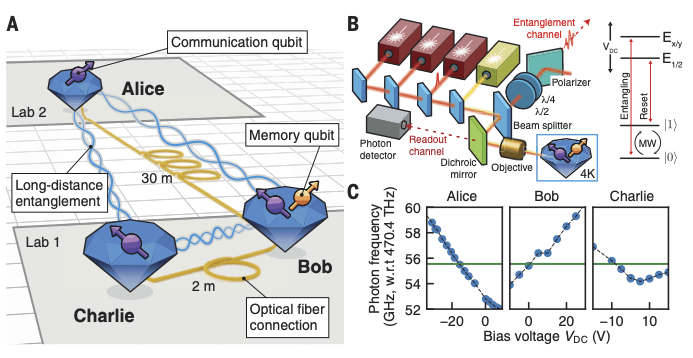Towards ubiquitous connectivity
The first steps towards a quantum internet were taken in the past decade by linking two quantum devices that shared a direct physical link. However, being able to pass on quantum information through intermediate nodes (analogous to routers in the classical internet) is essential for creating a scalable quantum network. In addition, many promising quantum internet applications rely on entangled quantum bits, to be distributed between multiple nodes. Entanglement is a phenomenon observed at the quantum scale, fundamentally connecting particles at small and even at large distances. It provides quantum computers with their enormous computational power and it is the fundamental resource for sharing quantum information over the future quantum internet. By realizing their quantum network in the lab, a team of researchers at QuTech – a collaboration between Delft University of Technology and TNO – is the first to have connected two quantum processors through an intermediate node and to have established shared entanglement between multiple stand-alone quantum processors.
Operating the quantum network
The rudimentary quantum network consists of three quantum nodes, at some distance within the same building. To make these nodes operate as a true network, the researchers had to invent a novel architecture that enables scaling beyond a single link. The middle node (called Bob) has a physical connection to both outer nodes (called Alice and Charlie), allowing entanglement links with each of these nodes to be established. Bob is equipped with an additional quantum bit that can be used as memory, allowing a previously generated quantum link to be stored while a new link is being established. After establishing the quantum links Alice–Bob and Bob–Charlie, a set of quantum operations at Bob converts these links into a quantum link Alice-Charlie. Alternatively, by performing a different set of quantum operations at Bob, entanglement between all three nodes is established.
Quantum Internet Demonstrator
This first entanglement-based quantum network provides the researchers with a unique testbed for developing and testing quantum internet hardware, software and protocols. ‘The future quantum internet will consist of countless quantum devices and intermediate nodes,’ says Ronald Hanson, who led the research team. ‘Colleagues at QuTech are already looking into future compatibility with existing data infrastructures.’ In due time, the current proof-of-principle approach will be tested outside the lab on existing telecom fibre – on QuTech’s Quantum Internet Demonstrator, of which the first metropolitan link is scheduled to be completed in 2022. The results of the study have also been supported by the European Quantum Flagship project Quantum Internet Alliance, which has the goal of developing ground-breaking technological advances in Quantum Communications, culminating in the first experimental demonstration of a fully integrated network stack running on a multi-node quantum network.
Read more.
This work is published in Science Realization of a multinode quantum network of remote solid-state qubits. Science, Vol. 372, Issue 6539 (2021) DOI: 10.1126/science.abg1919
The post Dutch researchers establish the first entanglement-based quantum network appeared first on Swiss Quantum Hub.



